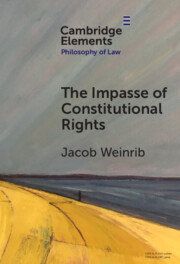Refine search
Actions for selected content:
235 results
12 - Compatibility of Selected ATP Rules with EU Economic Law
- from Part 2 - Regulatory
-
-
- Book:
- Professional Tennis and Transnational Law
- Published online:
- 07 August 2025
- Print publication:
- 21 August 2025, pp 263-284
-
- Chapter
-
- You have access
- Open access
- HTML
- Export citation
The Ethics of Defunding the Police
-
- Journal:
- Perspectives on Politics , First View
- Published online by Cambridge University Press:
- 25 July 2025, pp. 1-19
-
- Article
-
- You have access
- Open access
- HTML
- Export citation
11 - Confiscation and Forfeiture of Property in Connection with Alleged Unlawful Conduct
- from Part III - Criminal Justice
-
-
- Book:
- Core Concepts in Criminal Law and Criminal Justice
- Published online:
- 09 July 2025
- Print publication:
- 24 July 2025, pp 395-437
-
- Chapter
- Export citation
2 - Principles of Criminalisation
- from Part I - Criminal Law
-
-
- Book:
- Core Concepts in Criminal Law and Criminal Justice
- Published online:
- 09 July 2025
- Print publication:
- 24 July 2025, pp 13-54
-
- Chapter
- Export citation
Balancing as a Means of Judicial Activism? Analysis of the German Federal Constitutional Court’s Use of Balancing Language
-
- Journal:
- German Law Journal ,
- Published online by Cambridge University Press:
- 16 May 2025, pp. 1-22
-
- Article
-
- You have access
- Open access
- HTML
- Export citation
International Investment Law, Rule of Law, and Democracy: When the Solution Is Part of the Problem
-
- Journal:
- German Law Journal ,
- Published online by Cambridge University Press:
- 13 May 2025, pp. 1-23
-
- Article
-
- You have access
- Open access
- HTML
- Export citation
23 - Proportionality
- from Part II - Modalities
-
-
- Book:
- The Cambridge Handbook of Constitutional Theory
- Published online:
- 27 March 2025
- Print publication:
- 24 April 2025, pp 378-396
-
- Chapter
- Export citation
Neuroethics and treatment without consent
-
- Journal:
- CNS Spectrums / Volume 30 / Issue 1 / 2025
- Published online by Cambridge University Press:
- 11 April 2025, e39
-
- Article
-
- You have access
- Open access
- HTML
- Export citation

The Impasse of Constitutional Rights
-
- Published online:
- 04 April 2025
- Print publication:
- 06 March 2025
-
- Element
- Export citation
Proportionality and precaution
-
- Journal:
- Global Constitutionalism , First View
- Published online by Cambridge University Press:
- 03 April 2025, pp. 1-22
-
- Article
-
- You have access
- Open access
- HTML
- Export citation
The 2016 Reform of French Contract Law: Some Recent Developments
-
- Journal:
- Cambridge Yearbook of European Legal Studies , First View
- Published online by Cambridge University Press:
- 13 February 2025, pp. 1-15
-
- Article
-
- You have access
- Open access
- HTML
- Export citation
The overlooked importance of intelligence analysis in IHL
-
- Journal:
- International Review of the Red Cross / Volume 107 / Issue 928 / April 2025
- Published online by Cambridge University Press:
- 20 January 2025, pp. 287-310
- Print publication:
- April 2025
-
- Article
-
- You have access
- Open access
- HTML
- Export citation
3 - The Resilience of the Reciprocity Paradigm
-
- Book:
- Belligerent Reprisals from Enforcement to Reciprocity
- Published online:
- 12 December 2024
- Print publication:
- 19 December 2024, pp 113-147
-
- Chapter
- Export citation
Humanity on the final frontier: Challenges in applying international humanitarian law to modern military space operations
-
- Journal:
- International Review of the Red Cross / Volume 107 / Issue 928 / April 2025
- Published online by Cambridge University Press:
- 02 December 2024, pp. 200-237
- Print publication:
- April 2025
-
- Article
-
- You have access
- Open access
- HTML
- Export citation
4 - A Joint Enterprise
-
- Book:
- International Law and the Significance of Disciplinary Boundaries
- Published online:
- 21 November 2024
- Print publication:
- 28 November 2024, pp 84-124
-
- Chapter
- Export citation
4 - Objections, Alternatives, and Refinements
- from Part I - Symmetry Explained
-
- Book:
- Constitutional Symmetry
- Published online:
- 14 November 2024
- Print publication:
- 21 November 2024, pp 87-112
-
- Chapter
- Export citation
11 - Markets, Fairness, and the All-Affected Principle
- from Part III - Taming Economic Power
-
-
- Book:
- Empowering Affected Interests
- Published online:
- 14 November 2024
- Print publication:
- 14 November 2024, pp 196-210
-
- Chapter
-
- You have access
- Open access
- HTML
- Export citation
Faith, Trust, and Proportionate Resilience: A Discussion Note on “How Does Trust Relate to Faith” by McKaughan and Howard-Snyder
-
- Journal:
- Canadian Journal of Philosophy / Volume 53 / Issue 5 / July 2023
- Published online by Cambridge University Press:
- 04 November 2024, pp. 456-461
-
- Article
-
- You have access
- Open access
- HTML
- Export citation
Collateral kids: Weighing the lives of children in targeting
-
- Journal:
- Leiden Journal of International Law / Volume 37 / Issue 4 / December 2024
- Published online by Cambridge University Press:
- 08 October 2024, pp. 1018-1038
-
- Article
-
- You have access
- Open access
- HTML
- Export citation
5 - The Reasonable Person on the Battlefield
-
- Book:
- The Reasonable Person
- Published online:
- 30 May 2024
- Print publication:
- 06 June 2024, pp 106-131
-
- Chapter
- Export citation
